Dirty K 的东亚超科技锐舞轰鸣
Dirty K — けいこ Megamix
Shy People Mix
04.07 2022

上世纪 90 年代初,日本的泡沫经济达到顶峰(接近最终崩溃),促使一代人寻求享乐主义和奢侈。许多人转向俱乐部文化来寻求慰藉。
随着 Eurobeat 和 Italian Disco 在欧洲的衰落,J-Rave 为许多制作人提供了新的灵感。随着时间的推移,日本将这些影响融入到自己独特的俱乐部声音中:Hyper Techno(ハイパーテクノ),它在东京标志性的跳舞俱乐部 Juliana's Tokyo 中找到了神话般的地位。从 ACG(动漫、漫画和游戏)到亚文化(如 Gyaru Gal 和 Para Para 舞蹈),整个日本都感受到了这些场景的回响。大型唱片公司如 Avex Trax(及其无数分支如 SUPER EUROBEAT)推动这种声音成为主流,并为滨崎步这样的全球明星奠定了基础,这将形成千禧年东亚流行舞曲的雏形。
来自南京的音乐制作人 Dirty K 通过深入聆听和研究 1990 年代初期的东亚 DJ set,他学会将那一代 DJ 使用的特殊技巧融合在一起。我们邀请 Dirty K 将这些 Hyper Techno 音乐制作成精良的 26 分钟混音带,它浓缩了饱满情绪和异常高能的1990年代日式 Hyper Techno 音乐之集大成,以及呈现了当年对流行乐的互相影响。日本前卫音乐媒体网站 AVYSS 今天也会同时放送该混音。
“けいこ(稽古 / Keiko)” 一词是日本武道中的术语,指通过阅读古籍学习前人的经验,也指武术家的日常练习。
Art Work by Tsui Honagi

南京制作人 Dirty K 从上海厂牌 Genome 6.66 Mbp 开始崭露头角,在 Tzusing 的厂牌 Sea Cucumber 发布作品之后,将音乐焦点转至东亚区域的特有之声。而“Tokyo Renaissance”今年在伦敦 Eastern Margins 发表可谓一拍即合,因为后者的存在目的即是将东亚/东南亚创意力量散播到西方世界。
The term 稽古 (けいこ) "Keiko" refers to the Japanese martial art of budo. It is translated as learning well about ancient times by reading ancient texts, it also refers to the daily practice of a martial artist. Dirty K introduced this concept to the DJ world. Through extensive research and listening to DJ sets in East Asia in the early 1990s, he was able to incorporate the amazing skills of megamixes used by DJs of that generation and made the ハイパーテクノ (Hyper Techno) music during that time into an exquisite 25-minute mixtape.

Dirty K & LJC — Tokyo Renaissance / Kazumi
Dirty K 于今年发起了“Tokyo Renaissance”的音乐项目,旨在重新审视东亚俱乐部文化中的本地化之特定视角,以对抗互联网带来的同质化。
他和另一位中国制作人 LJC 钻研 1990 年代的锐舞文化及其东亚地区的突变,他们将日本 Hyper Techno 加速至自己的高能 Hi-NRG,塑造出激动人心的东亚俱乐部声音。最终,两人在伦敦厂牌兼活动组织 Eastern Margins 发布了 EP《Tokyo Renaissance / Kazumi》,日本制作人 T5UMUT5UMU 和 Wrack 奉献了各自混音版本。
At the start of the 90s, Japan’s bubble economy (baburu keiki) was at its peak (close to its eventual implosing), catalyzing a generation to seek out hedonism and extravagance. Many turned to club culture for their fix of the bright lights.
Following the decline of Eurobeat and Italian Disco in Europe, J-Rave provided a second wind for many of the producers. Over time, Japan incorporated these influences into its own distinctive club sound: Hyper Techno (ハイパーテクノ), which found mythical status in the iconic Juliana’s Tokyo. The reverberations of that scenes were felt throughout Japan, from ACG (Anime, Comics & Gaming) to subcultures like Gyaru ギャル and Para Para (パラパラ) dancing. Record labels such as Avex Trax (and its myriad offshots like SUPER EUROBEAT), would drive the sound into the mainstream, setting the scenes for global stars like Ayumi Hamasaki. This would form the embryonic beginnings of one strand of popular dance music in East Asia during the millennium.
Dirty K and LJC turbocharge Japanese Hyper Techno into overdrive, carving their own Hi-NRG, electrifying vision of East-Asian club sounds.